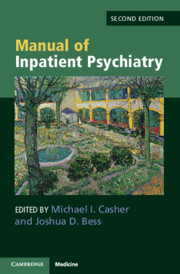Book contents
- Manual of Inpatient Psychiatry
- Manual of Inpatient Psychiatry
- Copyright page
- Contents
- Contributors
- Preface to the Second Edition
- Foreword: American Inpatient Psychiatry in Historical Perspective
- Chapter 1 The Inpatient with Schizophrenia
- Chapter 2 The Inpatient with Depression
- Chapter 3 The Inpatient with Mania
- Chapter 4 The Inpatient with Borderline Personality Disorder
- Chapter 5 The Inpatient with Dementia
- Chapter 6 The Inpatient with Traumatic Brain Injury
- Chapter 7 The Inpatient with Dual Diagnosis (Co-Occurring Disorder)
- Chapter 8 The Young Adult on the Inpatient Unit
- Chapter 9 Clinical Documentation on the Inpatient Unit
- Index
- References
Chapter 2 - The Inpatient with Depression
Published online by Cambridge University Press: 05 March 2020
- Manual of Inpatient Psychiatry
- Manual of Inpatient Psychiatry
- Copyright page
- Contents
- Contributors
- Preface to the Second Edition
- Foreword: American Inpatient Psychiatry in Historical Perspective
- Chapter 1 The Inpatient with Schizophrenia
- Chapter 2 The Inpatient with Depression
- Chapter 3 The Inpatient with Mania
- Chapter 4 The Inpatient with Borderline Personality Disorder
- Chapter 5 The Inpatient with Dementia
- Chapter 6 The Inpatient with Traumatic Brain Injury
- Chapter 7 The Inpatient with Dual Diagnosis (Co-Occurring Disorder)
- Chapter 8 The Young Adult on the Inpatient Unit
- Chapter 9 Clinical Documentation on the Inpatient Unit
- Index
- References
Summary
Most patients with uncomplicated depression can be treated as an outpatient, while inpatient care is generally reserved for people with severe or treatment-resistant depressive symptoms, significantly impaired reality testing due to accompanying psychosis, high suicide risk, and/or impaired self-care [1]. Many patients whose initial presentation is so severe as to warrant hospitalization will have “failed” outpatient treatment. Even though such patients already have an established outpatient team, the inpatient psychiatrist should be prepared to reevaluate the patient’s diagnosis and overall plan as part of a “fresh look,” and attempt to understand why the patient is not responding well to outpatient treatment.
Treatment-refractory depression patients are also sometimes referred for hospital admission with a specific plan for initiation of a course of electroconvulsive therapy (ECT) [2].
- Type
- Chapter
- Information
- Manual of Inpatient Psychiatry , pp. 28 - 62Publisher: Cambridge University PressPrint publication year: 2020



